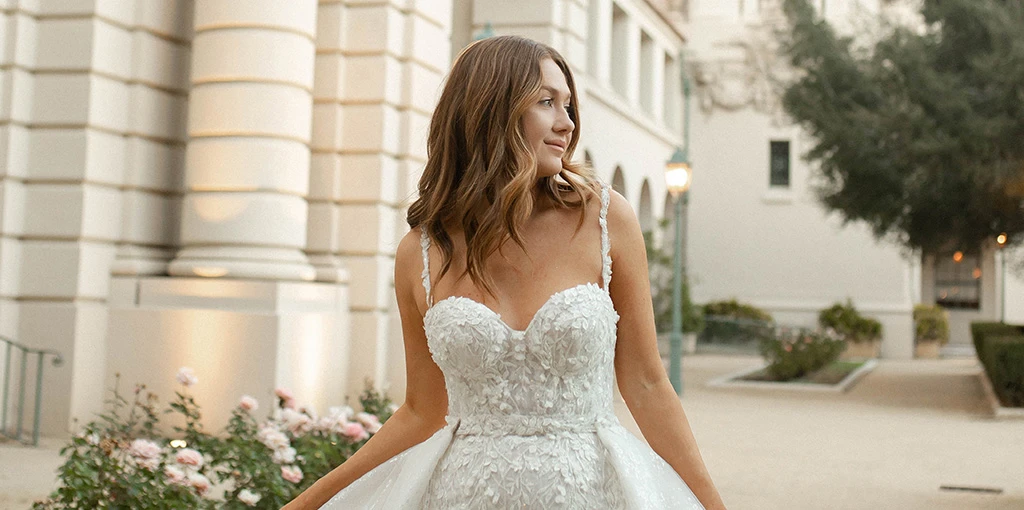When it comes to choosing the perfect wedding dress, most brides focus on style, silhouette, and detailing. But beneath all the sparkle and structure lies one essential element that defines the overall feel of the gown—fabric. From airy and romantic to structured and sleek, the fabric of a wedding dress influences everything from how it photographs to how it moves. Two of the most beloved materials in bridal design are lace and satin, but many other fabrics also play a leading role in bringing wedding dreams to life. This article explores the charm of these popular fabrics and what makes them stand out in bridal fashion.
The Romance Of Lace
Lace is traditionally related to bridal elegance. Its intricate patterns and delicate textures bring an air of timeless romance to any gown. Whether used as an overlay or incorporated into sleeves and necklines, lace adds detail without overwhelming the dress. Its beauty lies in its versatility. Chantilly lace’s intricate design gives it a classic appeal. On the other hand, Alencon lace—a heavier, corded version—offers a more pronounced texture, ideal for more structured gowns.
Lace is often the go-to fabric for brides, aiming for a traditional or vintage aesthetic. It’s also a favourite for outdoor and garden weddings, where the fabric’s light and airy feel complements the natural surroundings. Whether it’s paired with tulle for a fairytale look or layered over satin for a more formal appearance, lace brings softness and sophistication to any bridal ensemble.
The Luxury Of Satin
If lace whispers romance, satin speaks of sophistication and grandeur. Smooth, glossy, and heavier than other fabrics, satin is a staple in formal wedding gowns. For nighttime or winter weddings, it drapes well and has a natural sheen that catches the light. Satin lends itself well to clean, structured silhouettes like ball gowns, A-lines, and fit-and-flares.
What sets satin apart is its weight and formality. It holds its shape well, making it perfect for architectural styles and affordable wedding dresses with defined seams or dramatic trains. Satin can also appear in variations like duchess satin, which is particularly thick and luxurious, or charmeuse satin, which is lighter and more fluid. Brides drawn to classic elegance often gravitate toward satin for its timeless appeal and smooth finish.
Tulle For Ethereal Flair
Tulle may not be the main fabric of every dress, but its contribution to wedding style is undeniable. Often used in layers to add volume or as a base for lace appliqués, tulle gives gowns a dreamy and ethereal quality. Lightweight and sheer, it creates movement and flow, making it ideal for full skirts and veils.
Tulle is especially popular in princess-style gowns, where multiple layers create a cloud-like effect. It can be soft and romantic or stiff for added structure. Its versatility means it can be used to tone down an ornate bodice or elevate a minimalist design with sheer layers and subtle embellishments.
Organza And Chiffon: Light And Airy Elegance
Organza and chiffon are often confused due to their lightness and fluidity, but each offers a distinct look and feel. Organza is crisp and structured, holding its shape while still appearing delicate. Chiffon, on the other hand, is more flowing and soft, ideal for a breezy, romantic vibe.
These fabrics are excellent for brides who want movement without bulk. They’re commonly used in beach and destination weddings where comfort and breathability are priorities. They drape beautifully in layered skirts and look elegant in flowing trains or delicate capes.
Mikado And Crepe: Modern Minimalism
In recent years, minimalist bridal styles have surged in popularity, and fabrics like Mikado and crepe have taken centre stage. Mikado is a silk-nylon combination that is thicker and sheens. It’s perfect for structured gowns with clean lines and dramatic shapes. Crepe, in contrast, is soft, stretchy, and matte. It hugs the body in a flattering way and is often used for sleek, modern gowns.
These fabrics are ideal for brides who favour contemporary elegance. They require minimal embellishment because their strength lies in the silhouette and construction. With their understated beauty, they allow the bride’s natural presence to shine.
Finding The Right Fabric Fit
Choosing the right wedding dress fabric isn’t just about aesthetics—it also impacts comfort, movement, and practicality. Brides should consider the season, venue, and their personal style when selecting a gown. For instance, a heavy satin dress might feel too warm for a summer beach wedding, while a light chiffon gown may not offer the drama desired for a cathedral ceremony.
Trying on dresses in different fabrics can reveal a lot about what feels right. While a lace bodice may look gorgeous on the hanger, a bride might prefer the sleek feel of crepe or the movement of chiffon once she sees herself in motion.
Final Thoughts
Wedding dress fabrics do more than simply construct a garment—they tell a story. Whether it’s the intricate romance of lace, the smooth luxury of satin, or the lightness of chiffon, each fabric sets a tone and enhances the magic of the big day. Understanding these materials helps brides not only find a dress that looks stunning but also one that feels like a true expression of themselves. After all, it’s not just about how the dress looks—it’s about how it makes you feel when you walk down the aisle.




